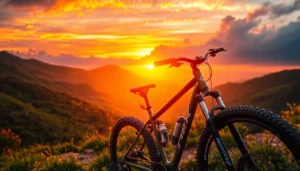Mastering Trek: Your Guide to Cycling Adventures and Gear Selection

Understanding the Different Types of Trek Bikes
Choosing the right type of Trek bike is fundamental to ensuring your cycling adventures are both enjoyable and effective. Whether you’re a city commuter, an off-road conqueror, or a speed enthusiast, the variety of trek bikes available today caters to diverse riding styles and terrains. Understanding these different categories—road, mountain, hybrid, and city bikes—helps cyclists select the perfect match for their specific needs, negotiating terrains smoothly while maximizing comfort and performance.
Road Trek Bikes: Speed and Efficiency
Road bikes are designed primarily for paved surfaces, delivering superior speed, lightweight handling, and aerodynamic efficiency. They are ideal for cyclists who aim to cover distances quickly, participate in racing, or simply enjoy fast cruising on smooth roads. High-performance materials like carbon fiber and advanced aerodynamic frames are common features that reduce weight and drag, allowing riders to achieve high speeds with minimal effort.
Popular models like Trek’s Madone or Domane series exemplify these features, blending cutting-edge engineering with comfort-enhancing geometry. Road bikes typically feature drop handlebars, narrow tires, and multiple gears to adapt to various inclines and road conditions. Whether you’re training for a race or embarking on long-distance rides, a dedicated road bike ensures maximum speed and efficiency.
Mountain Trek Bikes: Conquering Challenging Trails
Mountain bikes are built ruggedly, equipped with thick, knobby tires and sturdy frames capable of handling rough and uneven terrains. Their design emphasizes durability, traction, and shock absorption to navigate trails, rocky paths, and steep descents effectively. These bikes feature suspension systems—either front suspension (hardtail) or full suspension—designed to absorb impact and provide stability.
Trek’s mountain bike lineup spans from cross-country hardtails to aggressive downhill models, tailored for different mountain biking disciplines. Advanced frame materials like aluminum and carbon fiber keep weight manageable while maintaining strength. Mountain biking offers an adrenaline-fueled experience, and selecting the right mountain bike depends on the trail difficulty, riding style, and terrain conditions.
Hybrid and City Trek Bikes: Comfort and Versatility
For urban commuters and casual riders, hybrid and city bikes strike a balance between the speed of road bikes and the durability of mountain bikes. They often feature upright riding positions, comfortable saddles, and versatile tires that handle both paved roads and light off-road paths. These bikes are equipped with practical features like fenders, racks, and integrated lights, promoting functional everyday use.
Trek’s city and hybrid models prioritize rider comfort, ease of handling, and style, making them suitable for commuting, leisure riding, or short-distance errands. Technological innovations, such as internal gear hubs and lightweight frame materials, further improve efficiency and ease of maintenance.
Choosing the Perfect Trek for Your Adventure
Assessing Terrain and Riding Style
The foremost step in selecting your ideal trek bike is understanding the terrain where you’ll ride and your personal riding style. Beginners planning casual rides on urban paths typically lean toward hybrid or city bikes. In contrast, experienced cyclists seeking high-speed road racing prefer lightweight road bikes designed for speed and endurance. For outdoor enthusiasts venturing off paved roads—especially through forests or mountainous terrain—mountain bikes are essential.
Mapping out your typical routes enables precise decisions. For example, if your trails involve steep inclines, rocky surfaces, and uneven terrain, a mountain bike with full suspension might be necessary. Conversely, if your riding involves long-distance scenic routes on smooth roads, a lightweight road bike with aerodynamic features offers optimal performance.
Budget and Brand Considerations
Financial planning is critical when investing in a trek bike. Prices vary widely based on brand, materials, and features. Trek bikes, renowned for quality and innovation, span a broad price spectrum—from entry-level models suitable for newcomers to high-end racing or mountain bikes for advanced riders. Establishing a budget helps narrow options, but it’s crucial not to compromise on crucial features that enhance safety and performance.
Authentic brand reputation and warranty support are vital considerations. Trek, as a globally recognized brand, offers durable, well-engineered bikes with extensive after-sales service. To ensure value for money, consider purchasing from authorized dealers or certified outlets.
Features to Look for in a Trek Bike
Beyond brand and price, several key features influence the suitability of a trek bike:
- Frame Material: Aluminum is lightweight and affordable, while carbon fiber offers superior strength-to-weight ratio for performance bikes.
- Gearing System: Multiple gears allow adaptability to different terrains; internal hubs or derailleur systems can be chosen based on maintenance preference.
- Braking System: Disc brakes provide reliable stopping power in various weather conditions.
- Suspension: Essential for mountain bikes; choose between hardtail or full suspension based on trail difficulty.
- Wheel Size: 26″, 27.5″, and 29″ wheels each have advantages depending on riding style and terrain.
Tailoring these features to your riding plans ensures the bike not only performs well but also enhances your overall cycling experience.
Preparing for Your Trek: Essential Tips and Equipment
Safety Gear and Accessories
Proper safety gear is non-negotiable for any trek. Helmets are mandatory to protect against head injuries. Additional gear includes gloves for grip, padded shorts for comfort, and eye protection against debris. Reflective clothing or accessories increase visibility, especially during dawn, dusk, or night rides.
Accessories like multi-tools, tire repair kits, and pumps are crucial for on-the-go repairs. Lights—both front and rear—are indispensable for ensuring you’re seen by motorists and other cyclists.
Maintenance and Care Tips
Regular maintenance extends your bike’s lifespan and guarantees optimal performance. Basic routines include cleaning the chain, inspecting brake pads, and checking tire pressure before each ride. Periodic lubrication, gear adjustments, and professional tune-ups are recommended every few months, especially before long treks.
Storage in a dry, cool place and avoiding exposure to harsh elements will protect your investment. Investing in quality lubricants and cleaning supplies further simplifies maintenance.
Training and Route Planning
Adequate training prepares your body for longer or more challenging treks. Building endurance through gradual ride increments, incorporating hill repeats, and strength training enhances overall performance. Planning your routes with maps or GPS devices helps avoid the risk of getting lost and ensures you select paths suited to your skill level.
Involving local cycling communities or guided tours offers valuable insights into optimal routes, local conditions, and safety tips. Preparing physical and logistical aspects ensures a smooth, enjoyable trek.
Maximizing Performance: Expert Tips for Trek Riders
Optimizing Riding Technique
Mastering proper riding techniques significantly improves efficiency and reduces fatigue. Maintain a relaxed grip on the handlebars, keep your elbows slightly bent, and engage your core for stability. When climbing, shift to the appropriate gear early to maintain cadence, avoiding excessive strain.
During descents, shift your weight back for better control, and use brake modulation to prevent skidding. Cornering techniques involve leaning into turns while keeping your eyes focused on the exit, enhancing maneuverability.
Nutrition and Hydration Strategies
Nutrition influences stamina and recovery. Consume carbohydrate-rich snacks or gels during rides longer than an hour to maintain energy levels. Hydration is equally vital—drink water regularly and consider electrolyte drinks to replenish lost minerals, especially in hot climates or during intense exertion.
Post-ride nutrition includes proteins and carbs to facilitate muscle repair. Proper fueling ensures sustained energy and reduces risk of dehydration or cramping.
Tracking Your Progress and Setting Goals
Using GPS devices or smartphone apps enables tracking of distance, speed, elevation, and route history. Monitoring these metrics helps identify areas for improvement and motivates ongoing development. Setting realistic goals—such as increasing weekly mileage or conquering specific trails—keeps you focused and engaged.
Periodic assessment of performance data guides training adjustments, ensuring continual progression.
Connecting with the Trek Community
Joining Local and Online Cycling Groups
Engaging with local cycling clubs or online forums enriches your riding experience through knowledge sharing, camaraderie, and motivation. Group rides expose you to different terrains, riding styles, and maintenance tips, enhancing skills and safety awareness.
Platforms like social media, Strava, or specialized cycling communities enable connection with riders who share your interests and goals.
Participating in Races and Events
Races and endurance events offer milestones to test your skills, dedication, and progress. Participating in local or international cycling events fosters a sense of achievement and allows you to meet like-minded enthusiasts. Proper preparation, including targeted training and equipment tuning, maximizes performance during competitions.
These events also promote community building and enhance visibility for cycling as a sustainable transportation or leisure option.
Sharing Your Trek Experiences
Documenting and sharing your adventures inspire others and foster a supportive network. Blogging, social media posts, or photo galleries highlight scenic routes, technical challenges, and personal milestones. Engaging storytelling elevates the cycling culture and encourages more people to embrace this eco-friendly activity.
Your experiences can also serve as invaluable resources for beginners seeking guidance and motivation.





